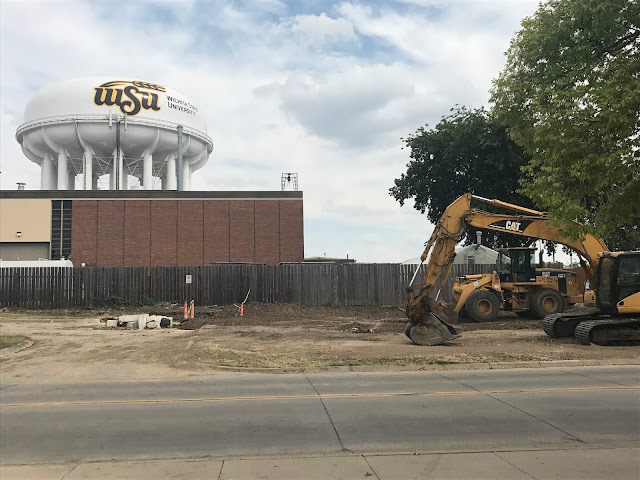we jumped back on Kansas Highway 96 and drove the 40-odd miles southeast to Wichita. Wichita is the largest city in Kansas, having begun life in the 1860's as a trading post on the Chisholm Trail. It became a destination for cattle drives north from Texas, earning it the nickname "Cowtown". During the 1920's and 1930's, Beechcraft, Cessna, and Stearman Aircraft companies were formed in Wichita, and the city continues to be a major center of the U.S. aircraft industry.
Prior to the 1750's the land between the Arkansas River and the Little Arkansas River was populated by the Wichita people, but they were driven out by the Osage. During the Civil War, the Wichita returned to the area and established a settlement on the banks of the Little Arkansas. During this time, John Chisholm established a trading post at the site, one of several along a trail extending south to Texas which became known as the Chisholm Trail. The Wichita people moved south to present day Oklahoma during this time.
The area had a reputation for lawlessness until local lawmen, Wyatt Earp among them, began to assertive police the cowboys. By 1880, the cattle trade had moved west to Dodge City when the Aitchison, Topeka, and Santa Fe Railroad arrived.
The arrival of the oil boom in 1915 triggered an economic boom in Wichita, and served as a springboard for oil moguls such as Fred C. Koch, who established what would become Koch Industries. By 1934, Stearman's Wichita aircraft facilities became part of Boeing. During World War II more than 20,000 workers labored in the Wichita aircraft plants, building airplanes for the war effort. Sadly, after V-J Day, 10,000 people were laid off in one week!
Wichita has been home to a number of prominent businesses, including A. A. Hyde, who founded Mentholatum in 1895, Sporting goods store Coleman started in the city in the early 1900's, and Pizza Hut in 1958. Due to it's central U.S. location, Wichita is a thriving crossroads for industry, and is home for some 390,000 souls.
Enough with the lesson....
We began our whirlwind tour of the city at the confluence of the Arkansas and Little Arkansas rivers, at a sculpture called Keeper of the Plains. This impressive work honors the intimate relationship of the native peoples and their environment. Arms outstretched, the Keeper seems to be asking for harmony and peace.
Wichita was a major gateway city during westward immigration, so this area with two navigable rivers became very important.
Our next stop was at The Old Cowtown Museum. Managed by the city of Wichita, this outdoor memorial to life during the 1870, is fascinating to see.
Many of the buildings available to view, both inside and out, are in their original locations. However, many have been moved from other locations in the Wichita area. We toured the....
Funeral Home.
General Store.
And the first Wichita home, the Munger House, built in 1868
After several hours of interesting exhibits, Sasha began to fade in the 85 degree heat, so we headed off to our next destination, the Original Pizza Hut. This unassuming building was the original building is the quintessential example of entrepreneurial success, having been the building where Frank and Dan Carney, Wichita State students, formed a multi-million dollar empire in 1958. WSU acquired the building and had it moved to a quiet spot on the campus, so we decided to check it out.
Turns out that the building is again being moved to another campus location and will become a museum. Just our luck!
By this time we were getting hungry, so we headed into Old Town to sample some goodies in a refurbished and revitalized warehouse district. Much to our surprise, the Diabetes Foundation had sponsored a bicycle Tour de Cure on Douglas Street, the main thoroughfare through downtown.
Stopping for a cup of Starbucks best for a little energy, we found quiet Roosevelt street in a mature neighborhood, where we stopped to look at the Frank Lloyd Wright Allen House. Commissioned in 1916 and built in 1918, the Allen House is named after its first owners, newspaper publisher Henry Allen. It was the last of the architect's famous prairie houses, which emphasized horizontal lines, earth tones and a blending on interiors and exteriors. The building is now a museum, open to the public on a guided tour basis only, but it was closed today.
The home has a tranquil patio area.
Donna and Sasha enjoyed their walk around the rear of the home!
Typical Frank Lloyd Wright details abound.
Difficult to see, but the tile roof pieces have an unusual shape to them, reminiscent of Asian influence.
The home is located on a quiet residential street with brick pavers. Families riding bikes, kids and dogs walking...it was very tranquil and peaceful.
The day was fading, so we stopped at Barn'rds, the home of the best roast beef sandwich. It was. Then off to Yoder and our temporary home to enjoy a prairie sunset.
Wow, what a day!




















No comments:
Post a Comment